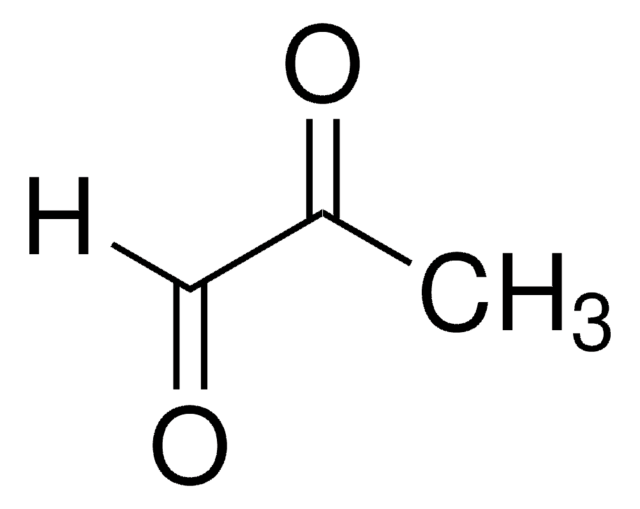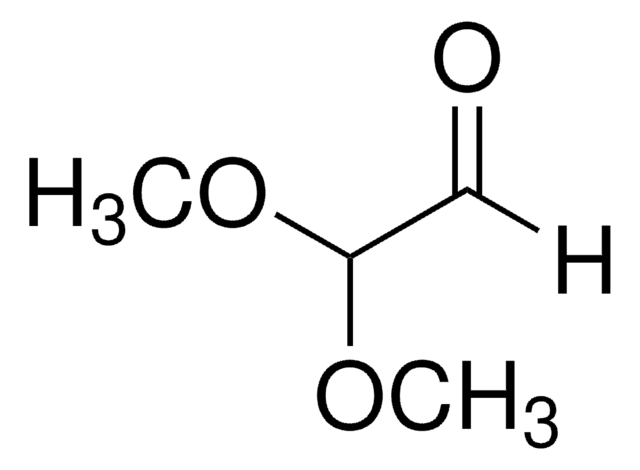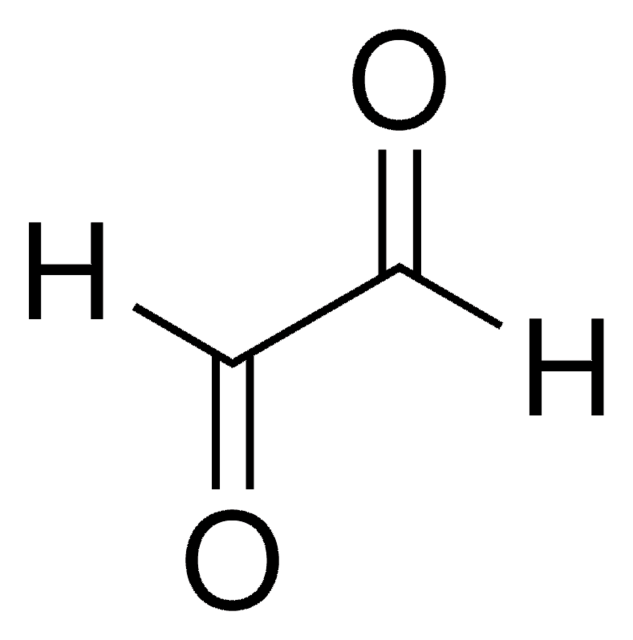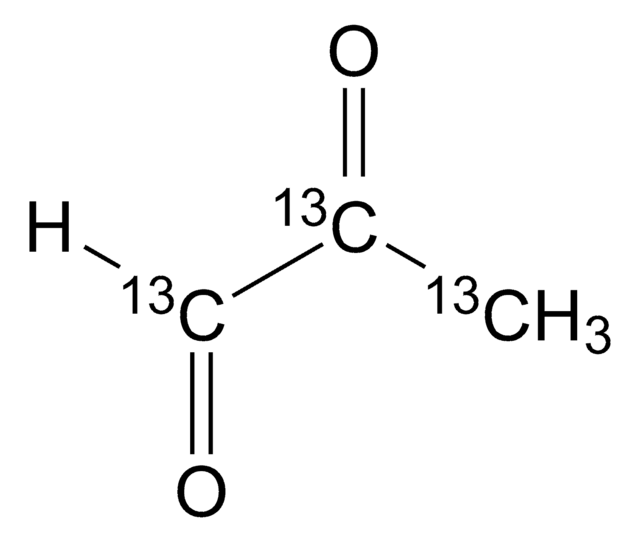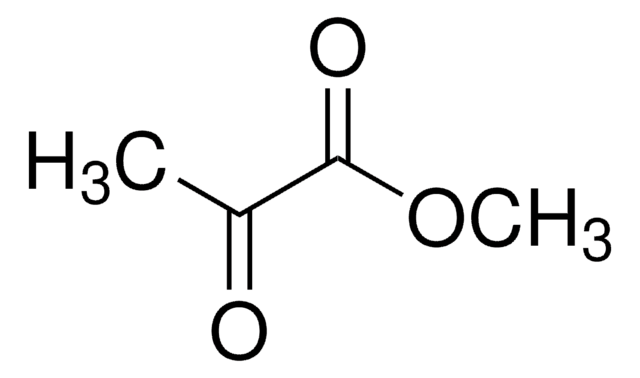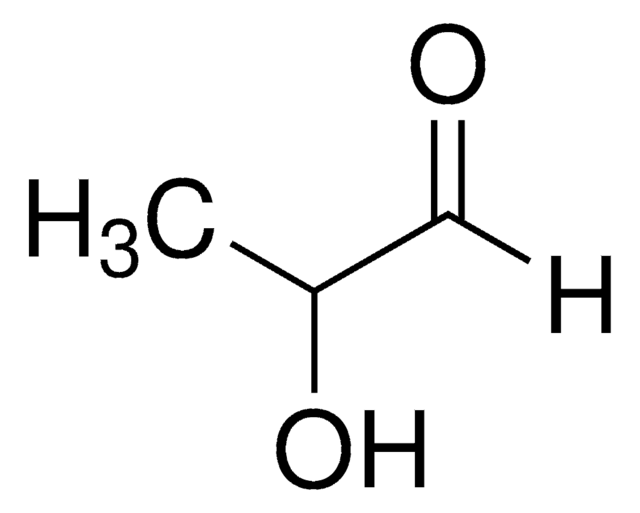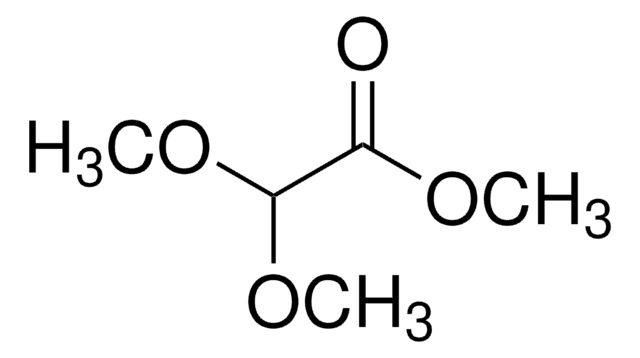All Photos(1)
Synonym(s):
1,1-Dimethoxyacetone, Pyruvaldehyde-1-dimethyl acetal, Pyruvic aldehyde dimethyl acetal
Linear Formula:
CH3COCH(OCH3)2
CAS Number:
Molecular Weight:
118.13
Beilstein:
1560557
EC Number:
MDL number:
UNSPSC Code:
12352100
PubChem Substance ID:
NACRES:
NA.22
Recommended Products
Quality Level
Assay
≥97%
form
liquid
refractive index
n20/D 1.398 (lit.)
bp
143-147 °C (lit.)
density
0.976 g/mL at 25 °C (lit.)
SMILES string
COC(OC)C(C)=O
InChI
1S/C5H10O3/c1-4(6)5(7-2)8-3/h5H,1-3H3
InChI key
ULVSHNOGEVXRDR-UHFFFAOYSA-N
Looking for similar products? Visit Product Comparison Guide
Related Categories
Application
Methylglyoxal 1,1-dimethyl acetal was used in the synthesis of methylglyoxal via hydrolysis in the presence of H2SO4. It was used to investigate the effects of methylglyoxal-mediated glycation on the structure, thermal stability and enzyme activity of yeast enolase in vivo.
Signal Word
Warning
Hazard Statements
Precautionary Statements
Hazard Classifications
Eye Irrit. 2 - Flam. Liq. 3 - Skin Irrit. 2
WGK
WGK 1
Flash Point(F)
closed cup
Flash Point(C)
closed cup
Personal Protective Equipment
dust mask type N95 (US), Eyeshields, Gloves
Regulatory Information
危险化学品
Certificates of Analysis (COA)
Search for Certificates of Analysis (COA) by entering the products Lot/Batch Number. Lot and Batch Numbers can be found on a product’s label following the words ‘Lot’ or ‘Batch’.
Already Own This Product?
Find documentation for the products that you have recently purchased in the Document Library.
K Ispolnov et al.
Journal of applied microbiology, 104(4), 1092-1102 (2008-01-16)
The purpose of this study was to investigate the behaviour of Saccharomyces cerevisiae in response to extracellular methylglyoxal. Cell survival to methylglyoxal and the importance of phosphates was investigated. The role of methylglyoxal detoxification systems and methylglyoxal-derived protein glycation were
Ajit Ghosh et al.
Scientific reports, 6, 18358-18358 (2016-01-07)
Glyoxalase pathway, comprising glyoxalase I (GLY I) and glyoxalase II (GLY II) enzymes, is the major pathway for detoxification of methylglyoxal (MG) into D-lactate involving reduced glutathione (GSH). However, in bacteria, glyoxalase III (GLY III) with DJ-1/PfpI domain(s) can do
Svetlana I Dorovskikh et al.
Biomedicines, 9(8) (2021-08-28)
This work is aimed at developing the modification of the surface of medical implants with film materials based on noble metals in order to improve their biological characteristics. Gas-phase transportation methods were proposed to obtain such materials. To determine the
Protein glycation in Saccharomyces cerevisiae. Argpyrimidine formation and methylglyoxal catabolism.
Ricardo A Gomes et al.
The FEBS journal, 272(17), 4521-4531 (2005-09-01)
Methylglyoxal is the most important intracellular glycation agent, formed nonenzymatically from triose phosphates during glycolysis in eukaryotic cells. Methylglyoxal-derived advanced glycation end-products are involved in neurodegenerative disorders (Alzheimer's, Parkinson's and familial amyloidotic polyneurophathy) and in the clinical complications of diabetes.
Giulia Milordini et al.
Frontiers in molecular biosciences, 7, 104-104 (2020-06-26)
Epidemiological evidence shows an increased risk for developing Alzheimer's disease in people affected by diabetes, a pathology associated with increased hyperglycemia. A potential factor that could explain this link could be the role that sugars may play in both diseases
Our team of scientists has experience in all areas of research including Life Science, Material Science, Chemical Synthesis, Chromatography, Analytical and many others.
Contact Technical Service